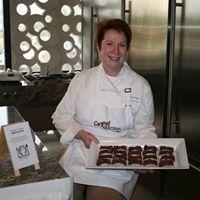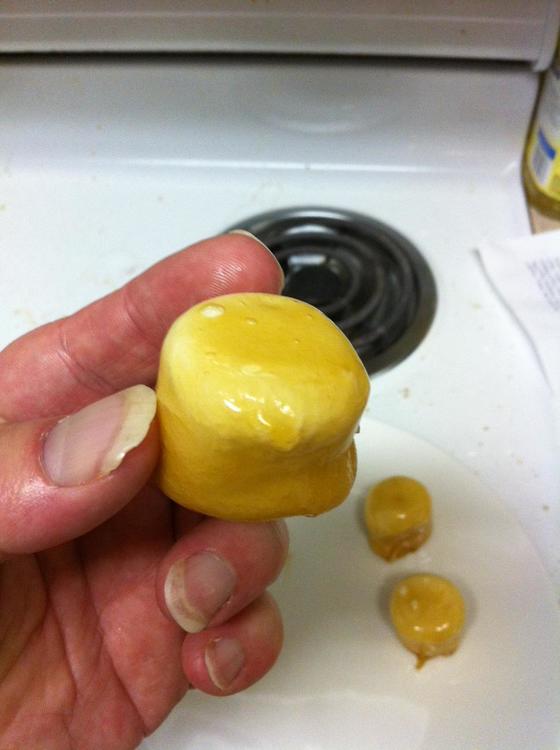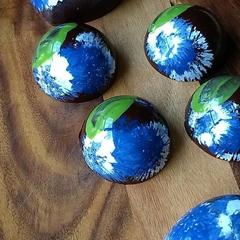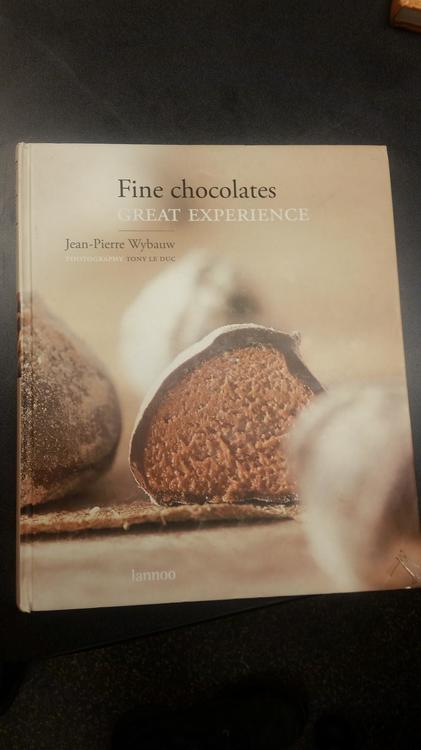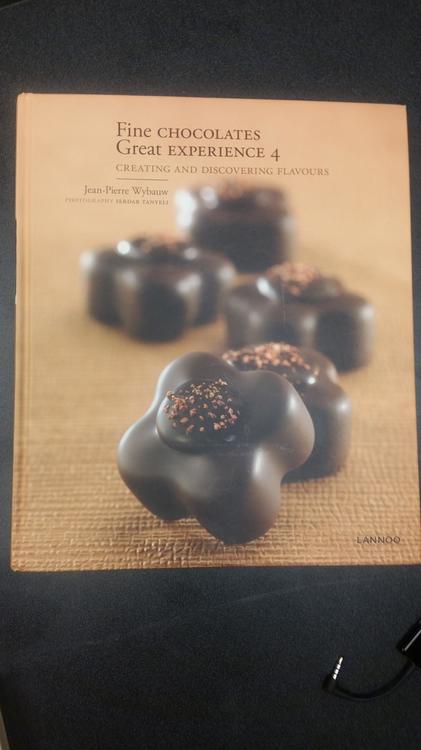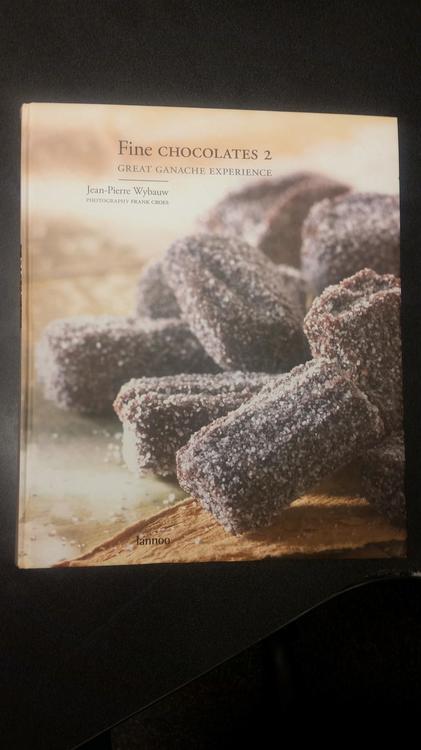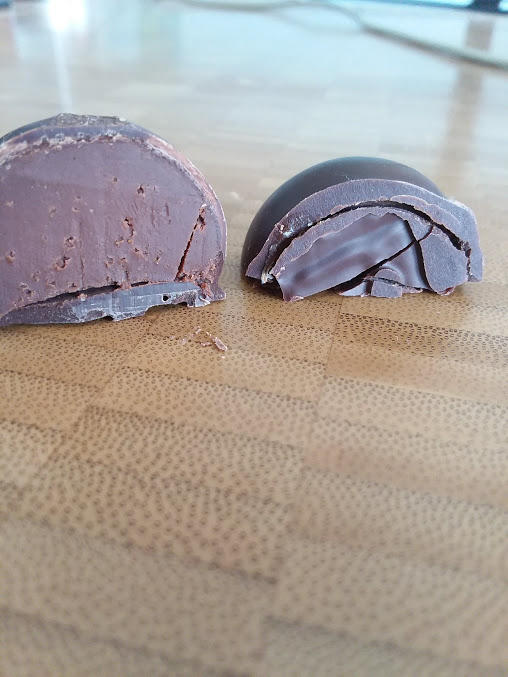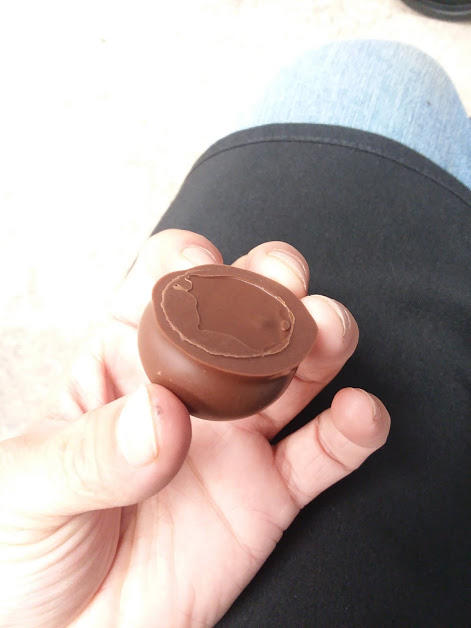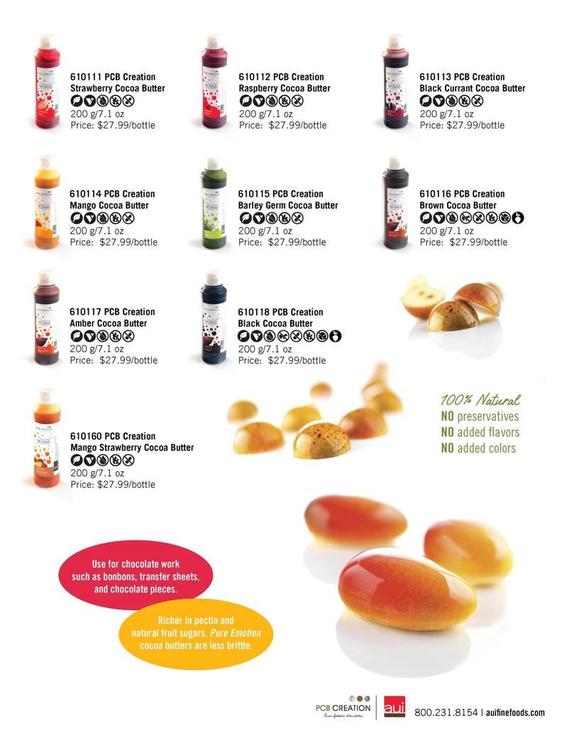Search the Community
Showing results for tags 'Confections'.
-
I have made caramel for several years but over the past few months it has not set up the same. Now, as it cools in the container it appears that the corn syrup is separating at the bottom. I have not altered my recipe and have not been able to figure out why this is happening. Any suggestions>
-
Does anyone have any tricks for making small balls of caramel (suitable for panning with sugar and chocolate)? So far I've tried making a batch of caramels, cutting them into little squares after they cool, and rolling them by hand into balls, but I very quickly run into the problem of the heat from my hands warming the caramels enough to release some of the fat from the butter in the caramel, making my hands too greasy for rolling. I could cool the caramels first to minimize this, but then they'd be too hard and won't change shape. I solved a similar problem when hand-rolling chocolate truffles by coating them in cocoa powder first - can I do something similar by tossing the caramel squares in powdered sugar first, or will that cause the caramels to crystallize?
-
I was curious if anyone has any experience making aerated chocolate candy (similar to those demonstrated by Grewling in Chocolates and Confections) that does NOT use a warmed ISI siphon to achieve this affect... https://www.pinterest.com/pin/827255025273299428/ I was wondering if it might be possible to adapt a large siphon so that you could attach a large tank of compressed CO2 or NO to avoid the expense of all the little gas canisters? Or am I just dreaming of something that's impossible?
-
Does anyone know of a source for a vegan confectioner's glaze suitable for sugar/chocolate panning (for sealing the candies from the Evils of the Outside World)? I have a couple of friends who are vegan or vegetarian, and I'd like to avoid being a total jerk if I can help it ("Look at these tasty treats I made THAT YOU CAN'T EAT!! MWAHAHA!!"). I need small quantities, as this is just for occasional home use.
-
Here's a fun little recipe I put together - it's a bit casual and unrefined, so I won't be at all offended if any experts jump in with improvements, but it's pretty easy to make, and makes a really tasty treat Toffee covered Marshmallows: 1 lb. bag large marshmallows (large homemade marshmallows should also work - feel free to give it a try) 1 1/2 cups sugar 1/4 cup light corn syrup 1/2 stick butter (or 1/8 lb., for non-US people who wonder what the heck a stick of butter is) A splash of water (yay for exact measurements! ) Also needed: 4 or 5 skewers (preferably metal), and a reasonably heavy coffee mug 1. Remove the marshmallows from the bag, separate them, and put them in a plastic bag or other suitable container in the freezer. It's OK if they are touching in the bag, but make sure they're not squished together. 2. After a few hours, add the rest of the ingredients to a saucepan (use just enough water to wet the sugar so it doesn't burn as easily) and cook on medium heat, stirring occasionally. 3. Cook the mixture until it just starts to turn brown - if you have a candy thermometer, this will be around 290F/143.333C. If you don't have a candy thermometer, just occasionally put a drop of the mixture on a white plate to check the color (then put "candy thermometer" on your shopping list, because candy thermometers are awesome) 4. Once it starts to just barely (but definitely) start to turn brown, take the pan off the heat, turn the stove burner down to very low heat, and put the pan back on (you want just enough heat to keep the mixture from cooling too much, but not so much heat that it continues cooking) - this is the toffee that you will dip the marshmallows into 5. Take the bag of marshmallows out of the freezer, stick a marshmallow on the end of a skewer, and dip it into the toffee. You must dip it quickly, so that the marshmallow doesn't melt, and also try to avoid dipping it in far enough that the toffee gets on the skewer (toffee on the skewer makes it really hard to remove the marshmallow cleanly) 6. Find someplace to stick the skewer while the toffee cools (this only takes a minute or so, but the toffee will stick to anything it touches until then, and it will probably drip until it cools). My recommendation is to put the aforementioned coffee mug on a plate (to catch drips), and place the end of the skewer in the coffee mug (see photo below) to hold it. 7. Once you've dipped the fourth or fifth marshmallow, the toffee on the first one you've dipped should be hard, and you can use a fork to ease it off the skewer so you can dip another marshmallow 8. Continue dipping marshmallows until you run out of marshmallows or toffee, or get tired of trying to keep them from sticking to each other in the coffee mug. Notes: -The heat from the toffee mixture slightly cooks the marshmallow, so you'll end up with a slight campfire-marshmallow flavor once you get through the thin candy shell - it's really quite tasty! -The toffee should drip off in long thin drips like in the photo (these easily snap off once the toffee cools. If you are instead getting thick oozing drips that make it look like the marshmallow is trying out for the part of "elephant" in the school play, you are dipping the marshmallows in the toffee for too long and they're melting - dip quicker -keep the marshmallows at least one inch apart in the coffee mug - if they make the slightest contact with each other, they'll stick permanently (and they make this really cool marshmallow-toffee bridge when you try to pull them apart). This will happen at least once in the process - just consider them samples for quality-control purposes -For those who are afraid of boiled sugar recipes, try this one out - just take your time and be very careful not to drip any toffee on yourself, and you should do fine. Feel free to message me if you have any concerns - I'm happy to help people get into candymaking -The toffee shell is quite happy to suck up any humidity in the air, so once they're made, they need to be eaten within a few hours or they start getting sticky on the outside - this is either a good point or a bad point Enjoy!
-
What are the best, darkest chocolates you've found in wholesale quantities? Aside from 100%, that is ... I'm thinking in the 75-90% range, available in quantities of 5-20 kg. It's definitely niche, but between the chocolate nerds and the low-carb-ers there's a market. Right now, 72% Felchlin Arriba is the darkest I use, in a bar with candied orange. I have not tried their Elvesia 74% or Sao Palme 75% but it looks like I can get them from AUI. A Felchlin 88% exists, but would be a special order arriving in a few months (their next container shipment?). Valrhona makes the Abinao 85% but that would be another special order. I'm pretty sure I tried it at one point and liked it. Does anyone keep it in stock? How is KaKao Berlin? They have a Brandenberg 75% but I'm not familiar with the brand. Any others? Or I could make my own and have the super dark be my one bean-to bar flavor ... thanks!
-
I'm a small-scale hobbyist candymaker (making things for myself and friends, not for sale), and I'm interested in learning more about sugar panning (mostly soft sugar panning, but also interested in hard panning). I recently made myself a panning machine, and understand the very basics of the process, but I'm finding it difficult to find thorough information on the process that is useful for home candymaking - most of the information I have found so far has been of the sort "here is how to use this product that you can only buy in 100-lb quantities", or "this $200 industry manual has a section on panning techniques that may or may not be useful, but you can't tell until after you buy it". Is there a good book/website/other source that thoroughly explains all parts of the panning process with enough detail to figure out how to do things with the materials at hand, and more importantly how to know at each step if things are going right? I have access to the book "Confectionary Science and Technology", which has been a HUGE help, but there's still quite a bit that it doesn't talk about. I also have a couple of specific questions, and would appreciate any info: 1. How do I add color? Adding gel food color to the syrup only provides slight coloration, and I have food color powder but am not sure if I should add it to the syrup, to the sugar, or just it to replace the sugar. 2. I have some carnauba wax to use for polishing, but I can't find any info on how to use it - do I just pour a small quantity of melted wax to the centers in the pan? Do I need to mix it with anything? Huge thanks in advance for any information you can provide.
-
Hello and Happy Holidays! I own an ice cream company and am looking for some information about equipment to use for scaling large batches of caramel. Right now, we cook sugar over electric heat in an approx. 6 qt. stainless steel pot. Once the caramel is at the correct color and temp (more on that below), we add our dairy to the hot mixture. Obviously, this is not a viable option for producing large batches. I'm familiar with confectionary equipment from Savage, but don't have the budget for an automated piece. Does anyone have experience with using just one of their copper or stainless steel kettles over a regular sized burner on electric heat? We've tried to use a single larger flat bottom pot sitting in the middle of all 4 burners on the stove to make a large batch of caramel, but it doesn't heat evenly. I'm wondering if the rounded bottom of the kettle helps the entire pot cook evenly -- would we be able to set the kettle right on the burner; or, have to use it in a double boiler setting? Additionally, any recommendations for thermometers that work well with caramel would be welcomed. We've used digital probes and candy thermometers, but on numerous occasions, the color and smell of the caramel that we associate with "doneness" is a dramatically different temperature for each batch. I came across a similar post on this topic from 2016, but aside from a recommendation for a large piece of equipment from Savage, there wasn't any other feedback. Hoping to get some good input that will bridge the gap between extremely small batches and mass production.
-
Hello everyone, I am in the process of locating a commercial kitchen space to rent in order to produce my chocolates on a larger scale, for retail and wholesale. The challenge is that I have not been able to locate a space that has air conditioning or any kind of temperature control. Even if everything else in the facility is perfect, that's the one issue that keeps coming up. Can anyone provide guidance regarding the feasibility of working in a non temperature controlled space, and if there are any work arounds? I'd have full access to fridges, freezers, etc... Thanks in advance for any help or experiences you can share! Miriam
- 18 replies
-
- Chocolate
- Confections
-
(and 1 more)
Tagged with:
-
Has anyone ever worked with or made buttercream candies? As far as I can tell they appear to be simply fondant sugar with the addition of butter. Any help would be appreciated. Thanks
-
Pistachio paste (and connected loosely, gianduja) Been studying through the giant book that is "Fine Chocolates Gold". It alternates between taking up a third of our dining room table and being a massive paper weight. 🤣 I'm trying to put together a plan for our fall/winter flavors and really want to work in more nuts and gianduja flavors. One of my customers wants more pistachio and another wants more hazelnut. First question: on Page 280, he has a recipe for "Pistachio Gianduja", which I thought meant making just straight gianduja with pistachios. But he puts in 4x the almonds as pistachios and then has you put in Pistachio Paste. What the what??? I thought that gianduja was what happens when you take nuts (turned into nut butter, essentially) and then added a certain percentage of chocolate to it (depending on the consistency you want). Then I researched pistachio paste. Does he mean the stuff from Italy or Turkey that has added milks and sugars or something else? Since he's a European chef, I'm assuming the first option... is that correct? Then... he keeps having the ingredient "gianduja" in recipes, but doesn't specify which nut they are made from. He does the same with "praline" as an ingredient. If he says that, is there an assumed nut as the base sort of gianduja? When he says "x" amount of praline as an ingredient, does he mean caramelized sugar that has been blitzed in the food processor, so as to bring it to powder form? Sorry - this sort of turned into a request for a mini class. 😏
-
Hello All, I am researching colorants for cacao butter with an eye toward 'natural' vegetal derived colorants. My local packaging inspector ( California ) has required me to list ALL FDA approved artificial dyes and pigments, FD&C, Lakes, on my labels. These are equivalent to EU approved artificial colors as E102 to E143, as I understand it. Is anyone else tackling this issue? Per labeling, this is a substantial amount of information as one multi-hued collection can have 6+ colors. Other chocolatiers I have noticed use blanket statements such as 'FDA approved colors' or 'Cocoa Butter with Colors'. I am hearing hints that the EU may impose stricter regulations on artificial colors. Some of these, Lakes for instance, seem very dodgy as they are based on metal (Aluminum) salts to disperse the dyes. Pur is one company that I have found that produces colorants from natural sources on an industrial scale. Their cacao butters include other additives so I am really interested in how well they spray and perform. Anyone have experience using these? Shelf life, color fastness, flavors in the colorants, all these are points of interest. Thank very much.
-
THE BOOKS ARE SOLD I have Volumes 1 ,2 and 4 of Jean-Pierre Wybauw's Great Chocolate books are for sale. The books are in great shape! There is some tape on the corner of the front of volume 1 that I used to keep it together after a drop. Volume 1 is also autographed by the author (See pics below). I'm asking $150 for the lot OBO. Let me know if interested or if you have questions
- 5 replies
-
- Cookbook
- Confections
-
(and 1 more)
Tagged with:
-
I want to put a soft marshmallow fluff into a bonbon. I’ve made this recipe lots of times for my s’mores macarons and it’s great but the recipe says it will only keep 2 weeks in the fridge (but it is actually fine much longer—at least no one in my family has died yet ). https://www.google.com/amp/s/www.chowhound.com/recipes/homemade-marshmallow-creme-30296/amp Does anyone know of a soft marshmallow cream recipe I can pipe into a bonbon and leave at room temp for a couple of weeks? I know the commercial stuff will separate long before it goes bad (don’t ask ).
-
Who here hand dips chocolates, either with their actual hand, or with a fork? I have a side job working with a woman who hand dips everything with her fingers in a puddle of chocolate on a sheet of parchment. She's super fast at it, I tried it but it felt so messy and awkward. I have done a little fork-dipping, so today dipped 300+ cookies with a fork and remembered why I hate fork dipping. So, anyone have any pointers, tricks, or favorite dipping forks that don't make your hand go numb? Today I used a dinner fork, I didn't have my actual chocolate dipping forks, but they have really thin metal handles that are hard to hold onto and horrible. I need like the Good Grips version for people with arthritis and pastry chefs who have done too much piping ...
-
I've been working with the Boiron purée recipe tables (chocolate and PdF, ice cream) - some good successes. However the document is very terse and I wondered whether anyone who is experienced with these formulae might clarify what the expected result is: - "Fruit ganaches" and "Fruit and caramel ganaches". I think these are supposed to produce a ganache for cutting and enrobing, although when I tried it came out far too soft to be dipped??? - "Ganaches to be combined with fruit pastes" - I think these are to be layered above PdF and enrobed - is that right? - "Chocolate molded sweets" - Are these intended to be served as is, ie moulded without a layer of couverture going into the mould first? However the instructions talk about pouring into a frame. - "Fruity delight" - looks like a fairly light dessert to go into a parfait glass. Has anyone done these and how do they turn out? How do they compare to the sabayon-based ones in the Boiron ice cream book? I'm going to start working through some of the ice creams next week and it will be interesting to see how these turn out. Thanks for any advice.
-
I used my homemade toffee in a cookie recipe hoping that the toffee will add a crunch to the cookie... it didn't turn out well as the toffee melted and didn't keep its hardened crunch form. How can I prevent my toffee from melting in my cookie recipe?
-
- Troubleshooting
- Cake
-
(and 2 more)
Tagged with:
-
So I've been experiencing cracks on the foot of my bonbons that I've been unable to find the cause of, hoping to reach out to the community to get to the bottom of this costly problem. I work for a small chocolate company that makes our own bean to bar couverture. We use a continuous tempering machine with enrobing belt attachment. The process: ganache is made and then piped into round silicone molds, which are then footed with tempered chocolate before being placed in the freezer until frozen enough to pop out of the molds. They are then set up right and left to thaw and dry out overnight on a equipped with fans aimed at the bonbons. The next day we send the bonbons through the enrober, and then they are transferred to a speed rack to set up, either at room temp (generally around 68-70 degrees F) or in a homemade cooling cabinet (an insulated box equipped with an air conditioner + dehumidifier + fans) that generally fluctuates between 50-56 degrees F (I know, large range). Problems occur with both milk and dark couverture, with bonbons kept at room temp or in cabinet, thickness of foot doesn't seem to make a difference (we've tried thicker and thinner). Crack doesn't immediately appear; it usually takes a couple of minutes after being completely set before showing. It looks as though the foot is popping out, cause a hairline crack between the shell and the foot. I've attached pictures. You'll notice in the photos, that when the bonbon is cut in half, the foot separates from the shell pretty significantly. Thoughts? Suggestions? Similar experiences?
- 3 replies
-
- Chocolate
- Confections
-
(and 1 more)
Tagged with:
-
Does anyone have any experience using Knobel depositing machines? My one shot plate is leaking chocolate out of the top and I can't determine why. Any help would be appreciated
-
Has anyone ever performed chocolate panning in a large industrial machine and used a single vessel for the panning AND the polishing steps? The place i work has only one drum and I'd like to make use of it without purchasing a second drum. Any advice would be appreciated!
-
Does anyone know of a natural alternative to using potassium sorbate as a marshmallow preservative??? Would citric acid or sorbitol suffice???
-
The current issue of the NY Times Magazine is on candy. Shamefully sinful. I cannot unsee the images.
-
I have an opportunity to obtain (without a trip to NYC, where everything appears available) some hard-to-find liqueurs or brandies for my chocolate work, primarily in ganaches. I already have a poire Williams eau-de-vie and a framboise one as well. I have German kirschwasser but am getting low on that, so am thinking of getting more while I have this chance. For new ones, I'm thinking primarily of apricot. I have heard there are some wonderful European apricot brandies/liqueurs, but don't know which really taste of apricots and are worth purchasing. And the other flavor I would like is a strawberry brandy or liqueur. Online I've found Dolceterra Marcati wild strawberries liqueur and Drillaut strawberry liqueur but know nothing about either. I lean more toward a liqueur/cordial than eau-de-vie because sometimes I think the latter does not always taste specifically of the fruit. Any guidance would be much appreciated, including ideas for fruits I haven't mentioned.
-
Hello, folks, thanks for reading. My husband thinks, I should start selling my popcorn seasonings (which I make for my family), it’s a good product. But I'm not sure if it’s interesting to other people... So, what do you think, guys? Our story: We’ve bought an air popper machine, but popcorn came out pretty tasteless. Then, we’ve bought different “popcorn seasoning” mixes... But it always ends with all the seasoning at the bottom of the bowl. Then, we've added butter, oil and so on before seasoning... we got soggy, chewy popcorn. Lot’s of disappointments… When we almost gave up… the magic happened! I figured out the way to make seasonings that: Stick to popcorn, but not sticky to fingers (or T-shirt , Easy to apply, May be pre cooked in bulk and stored… And popcorn appears crunchy, tasty, thoroughly covered with seasoning. Sounds good, yep? Now, when I want to treat myself - I only need 2 mins to turn tasteless popped popcorn to a real treat. The only moment - it request 1 extra effort: after you toss it over popcorn, you need to microwave it for 1 min, and stir after. So, I was wondering, if you like popcorn like myself - would this seasoning be interesting for you to purchase? Are you ready for a little extra work (microwave & stir) in the goal to flavor popcorn, or it feels too much effort? As I have no experience in manufacturing and retail, your answers would help me to make a very important decision - to dive in or not... Thanks in advance for your answers, it means the world to me.
- 14 replies
-
- Troubleshooting
- Confections
-
(and 2 more)
Tagged with:
-
This looks interesting - I know some of us have lamented the lack of flavor or off flavors of additives to colored cocoa butter - anyone seen or tried these? Looks like they can be used either to mix into chocolate as a fat-based flavor or to decorate molds as usual with colored CB ... More expensive than Valrhona Inspiration or regular colored CB, I wonder how they compare in flavor intensity, the Valrhonas I've tried were fairly intense. I also wonder what flavors brown, black, and amber are ... https://www.pcb-creation.com/pure-emotion-colour-by-pcb-creation/?lang=en Edited to add: the black/ brown flavors are chocolate, of course! 🙃

